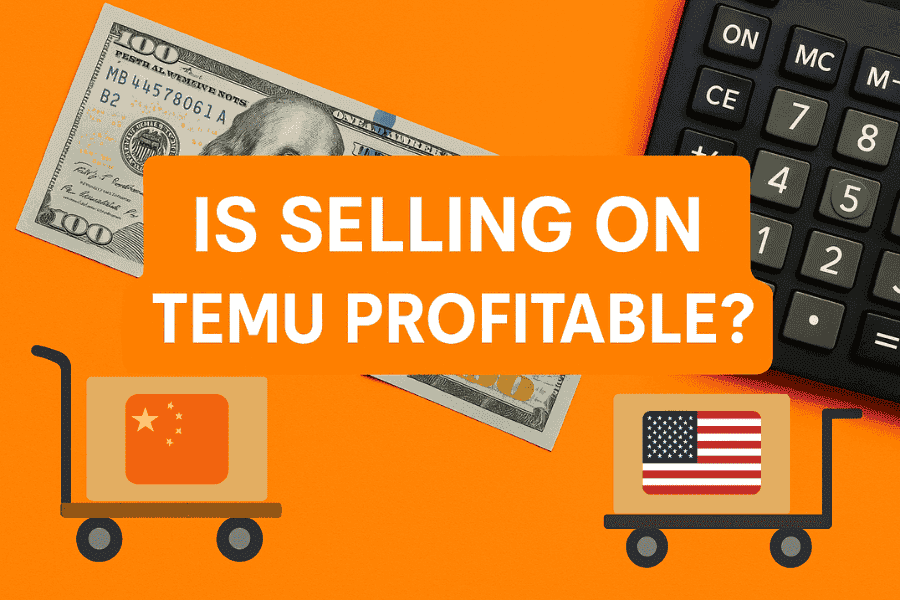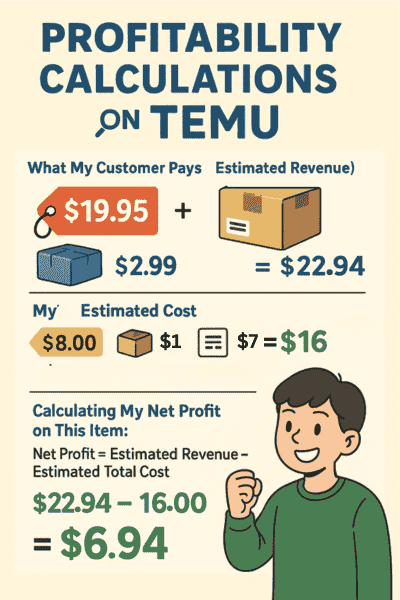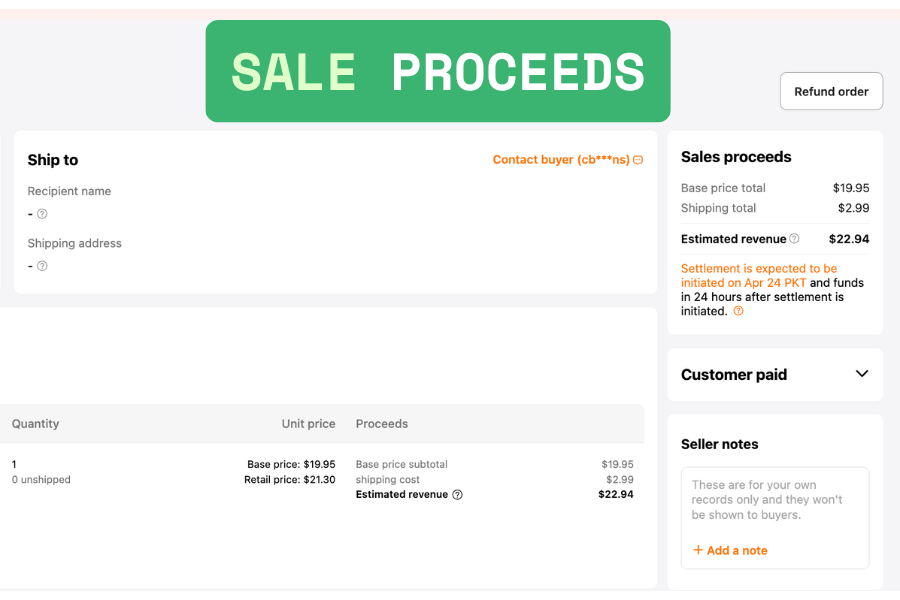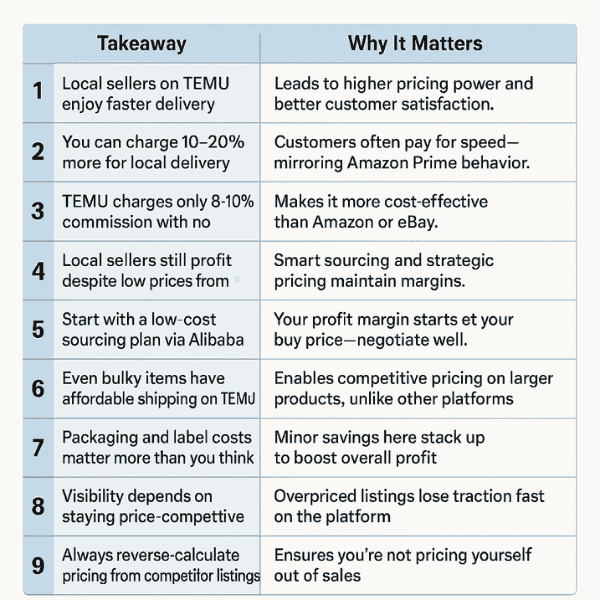Online selling aims for revenue and profit. So, is selling on TEMU profitable when compared with TikTok Shop, Amazon, and Shein? Knowing what drives success on TEMU is essential.
Generating Profits is broadly achievable across most marketplace platforms. The subsequent crucial Factors Determining Success include
- your chosen Business 💼 Model
- Product 🏭 Sourcing 🚚 Channels
- the Target 🌍 Country of origin of goods
I understand what gives you a winning edge on platforms like TEMU and how to make your selling journey worthwhile
- primarily, securing items at 💲 Unbeatable Prices.

Gap for Early Birds to sell on TEMU
The current low number of local sellers on TEMU strongly suggests that the presence of USA-based sellers with inventory in the USA, shipping from their own warehouses to end customers, is significantly limited. This presents a clear competitive advantage in terms of faster delivery to end customers compared to the numerous international sellers, predominantly based in China (including traders and manufacturers).
How to Stay profitable on TEMU against cheap China sellers?
Based on my experience selling on TEMU for the past two quarters, I can confidently say that it’s possible to remain profitable even when competing with China-based sellers who often source directly from local factories and offer very low prices.
Here’s a thought: For those considering resell items from TEMU, products priced below $7 can prove particularly effective on other platforms.
Local Delivery Wins on Time vs. Price.
Being a local seller on TEMU offers a competitive advantage, allowing for roughly a 10-20% price premium. This privileged advantage is primarily driven by the fact that customers on TEMU are often willing to pay $11-$12 for an item instead of $10 when they can receive it within 5 days, compared to the 2-3 week delivery timeframe offered by many international sellers. This customer behavior of paying more for faster delivery is evident with Amazon’s Prime membership.
Consequently, you can capture a larger share of sales for products matching those of international sellers. How much higher can the price be? In my experience, charging an extra $5 still resulted in good sales for my SKUs.
Understanding TEMU Fees
Unlike Amazon, which charges a fixed monthly fee (e.g., $40) and eBay, which applies listing fees, TEMU does not have a recurring monthly charge. TEMU’s primary fee is a relatively low commission on the selling price, ranging from 8% to 10%, in contrast to Amazon’s typically higher commission rate of around 15% on most items.
Understanding My Profit on TEMU: A Real-Life Example
Let me walk you through the numbers for one of the items I actually sell on TEMU, so you can see how it works in practice.

1. What My Customer Pays (Estimated Revenue):
- Base Price of the Item: $19.95 (This is what I receive after TEMU’s commission)
- Shipping Cost Paid by Customer: $2.99
- My Total Estimated Revenue: $19.95 + $2.99 = $22.94
- This is the total I get from the customer for the product and the shipping fee.
2. My Costs to Get This Item Ready to Ship:
- Item Landing Cost (getting it to my NJ warehouse): $8.00
- Packing Box: $1.00
- Item Label Cost: $7.00
- My Estimated Total Cost: $8.00 + $1.00 + $7.00 = $16.00
- These are the costs I incur to have the item in my hands, packed, and labeled, ready to go to the buyer.
3. How TEMU’s Fees Worked for This Sale:
- The price the customer initially saw on TEMU was “Retail price: $21.30”.
- After TEMU took their commission (which is between 8% and 10% for my category), I received the “Base price total” of $19.95. So, the commission is already factored out here.
4. Calculating My Net Profit on This Item:
Now, let’s see the profit I made after all the costs:
- Net Profit = Estimated Revenue – Estimated Total Cost
- Net Profit = $22.94 – $16.00 = $6.94

My Takeaway:
As you can see with this specific product, even with TEMU’s commission taken into account in the base price, there’s still a decent profit margin to be made. The key for me is to carefully track all my expenses, from the initial cost of the goods to the packaging I use here in New Jersey. This helps me ensure each item I sell is actually contributing to my overall profitability on the TEMU platform.
Selling Tutor TEMU Profitability Calculator
Quickly estimate your per-item profit with the Selling Tutor TEMU Profitability Calculator.
Simply enter your base price, shipping fee, and item-specific costs like landing, packaging, and labeling.
The tool calculates your total revenue, total cost, and net profit — helping you sell smarter on TEMU.
Selling Tutor TEMU Profitability Calculator
Enter your pricing and cost details below to instantly calculate your total revenue, total cost, and net profit per item.
Case study of My TEMU Pricing Experience: Local vs. Global
Let me share my experience selling aforementioned Home & Kitchen (Laundry) item on TEMU:
I’ve observed that other sellers, who are mostly based in China, offer similar items around the $18 mark. I currently list mine at a total of $23, which is a noticeable difference. At this higher price, the number of orders I receive is significantly lower – only about one-tenth of the total orders for comparable items on TEMU.
This really highlights the balancing act between price and sales volume. While I might make more profit on each individual sale at $23, the lower number of sales impacts my overall earnings.
Initially, TEMU’s platform seemed to give my listing some visibility at this higher price point. However, over time, I’ve noticed a push from the platform to lower my prices to stay competitive and maintain traffic to my product. They even suggest that if I don’t adjust my prices downwards, my product’s visibility might be limited.
How to Set the Right Prices on Temu?
When I’m analyzing potential products to source for TEMU, I now look at the lowest selling price for similar items already listed. I treat that as my target selling price. If I can calculate a small profit margin (around $2, for example) at that lower price, then I consider it a viable product to sell. This approach seems crucial for staying competitive and profitable on the TEMU platform in the long run.

Want to Grab the Biggest Slice of TEMU Sales?
The winning formula on TEMU, as we’ve already established, is competitive pricing – it’s that simple. Before you even think about selling an item, your first move should be to reach out to Alibaba suppliers to negotiate the lowest possible cost. Once you have that, incorporate it into your profit calculations based on the selling price you’re aiming for.
I am sure, now you know that selling on TEMU is profitable, just grab the right documents for selling on TEMU and get started.
How Do I Know What the Pricing of a Label on TEMU Would Be?
Think of TEMU’s shipping label costs like this: the heavier your package, the slightly more you’ll pay for the label, but overall, it’s quite reasonable, especially for heavier items compared to other platforms.
Here’s a rough idea based on your experience using the cheapest option (UPS Ground Advantage within TEMU):
- Small & Light (Under 1 lb, like 340 grams): Around $4 per label.
- Around 1 lb: About $5 per label.
- Around 2 lbs: Roughly $7 per label.
Good News for Bulky Items:
One of the great things about TEMU is that shipping labels for heavier and oversized items aren’t as expensive as you might expect on other platforms. For example, even if your product weighs around 10 kg (about 22 lbs), the label might only cost you around $9-$10.
Smart Tip:
Even if you’re selling bulky items, it’s generally a good idea to try and use standard-sized packaging if possible. This can help keep your label costs manageable.
In short: TEMU offers pretty good rates for shipping labels, especially when your items are on the heavier side. Just remember that the price will go up a little as the weight of your package increases.
To conclude Is Selling on TEMU Profitable
In conclusion, determining whether is selling on temu profitable demands a nuanced grasp of several key factors.
The platform offers benefits like lower commission fees and potential price premiums for local sellers with faster shipping. However, success depends on securing competitively priced products and efficiently managing operational costs. This directly impacts whether is selling on temu worth it for individual sellers.
The presented case study shows that profitability is possible through careful expense tracking and strategic pricing, even against international competition.
Ultimately, TEMU’s profitability isn’t guaranteed. Instead, it’s a direct result of a seller’s ability to source affordably.
Understanding the platform’s fee structure and leveraging one’s position, especially as a local vendor with quicker shipping, is crucial.
The emphasis on competitive pricing highlights the need for thorough cost analysis and market research before selling on the platform.
FAQs
1 – Can anyone sell on TEMU?
Setting up a seller account on TEMU is straightforward. You can register as an individual or as a business entity. To begin, you’ll need to request a store invitation link by emailing the TEMU seller team at “seller@temu.com”.
2 – Is it allowed to sell any product on TEMU?
While TEMU doesn’t have as many restricted categories as Amazon, it’s generally open for most products. However, when listing electronics, ensure your product packaging photo clearly displays FCC or FCE declarations to avoid listing violations.
3 – How can I avoid losing profits while selling on TEMU?
A key strategy to protect your profits as a new TEMU seller is to concentrate on products priced in the $15-$25 range. This price bracket on TEMU can offer a significant advantage, similar items often retail for $32 to $40 on Amazon.
Leave a Reply